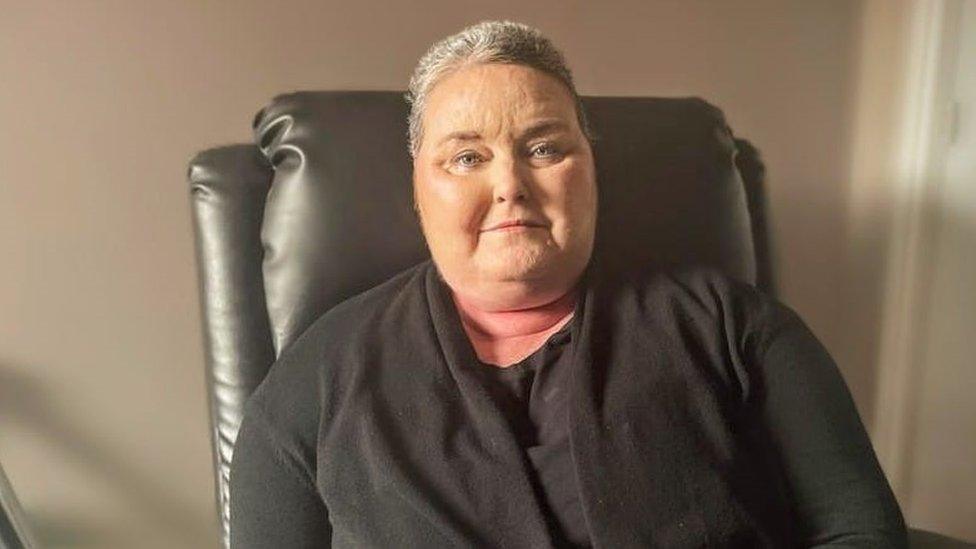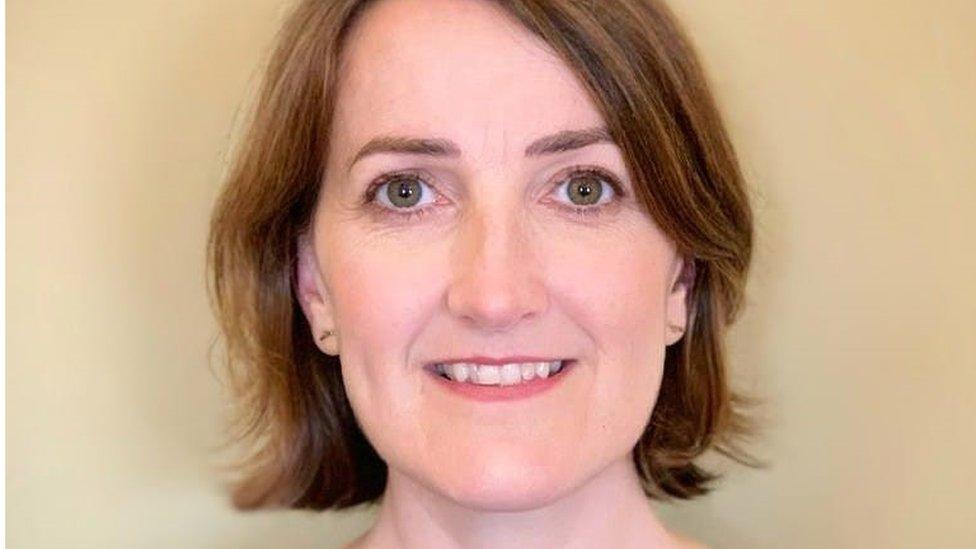Cutting hospice beds to help people die at home
- Published

Lisa Potter has been receiving end-of-life care after at her home in Dunfermline
The number of people dying in their own homes has risen since the Covid pandemic and one Scottish health board has taken the controversial step of cutting hospice beds to provide more palliative care in the community.
Over the past three years, NHS Fife has adapted its service by closing more than half its hospice beds to try to reach more patients at home.
The move has caused local controversy, with many calling for hospice beds in Dunfermline to be reinstated, but specialist teams say they are now able to respond more quickly and flexibly to people in pain and distress.
Lisa Potter is one of those receiving end-of-life care after at her home in Dunfermline.
The 52-year-old was first diagnosed with cervical cancer in 2017 but had been all-clear for almost five years when hip pain was revealed to be cancer and it was incurable.
Lisa said the hardest part was for her family as they watched her get more ill.
"They're all there and they feel helpless and don't know what to do," she said.
"There's nothing they can do, they've just got to stand-by and hope for the best and hope that I'm comfortable."
After a stay in hospital, her health deteriorated and Lisa wanted to be cared for at home where she has enjoyed the "little things" like family TV nights and her own bed.
She said "there's not a lot of independence" with her illness but that she wanted to stay at home as long as she was comfortable then die in the hospice.
"I think it's great I've got that choice," she said.
"It makes it easier for me. I know I'm getting the choice to go to the hospice and my family are not watching me die upstairs."
Deaths at home
Most people still die in hospital but the number of people dying at home has been increasing in recent years.
It reached a peak level in early 2020 at the height of the Covid pandemic but has remained high since then.
Figures for March 2023 show there were 1,782 deaths at home or in non-institutional settings, which was 17% above the five-year average.
The latest figures show that last week almost a third of deaths were at home (365).
As more people live longer with long-term conditions and advanced illnesses the demand has grown for end-of-life care a home.
In Fife, palliative teams work with GPs, district nurses, care home staff, hospital clinicians and charities to support people living with terminal conditions.

Dr Jo Bowden said work had been ongoing for years to change the service
Dr Jo Bowden, a consultant in palliative medicine, described the greatest value of her specialist team as their ability to respond when people's needs changed quickly - whether that was because of distress, physical symptoms or family circumstances.
She said work had been ongoing for years to change the service but at the start of the pandemic fewer people wanted to come into the hospice so they had too many nurses and doctors in that facility but not enough working in the community.
"Preferences often change with time but very clearly most people would choose to spend most of their time as their illness advances and towards the end of life at home," she said.
"It's not possible for every person but even for those people who need to come in either for a short spell or at the end of their lives the majority of their life lived will be at home.
"So that tells us that the majority of our resource needs to be there," Dr Bowden said.
Inpatient care
Eleven beds in the hospice were closed to free-up staff and provide care that had only previously been available in the hospice setting. That has left eight hospice beds in the area.
Prior to the pandemic, the specialist team could look after a maximum of 19 patients but that has increased to 60 people under the changes.
Staff had previously only been able to work in particular settings but have changed to being able to work in any care setting on any day.
Demand for hospice care remains significantly lower than pre-pandemic in Fife. Since the changes, waits for a hospice bed have halved to one and a half days.
Before the pandemic 80% of the service budget was spent on inpatient care.
"We absolutely acknowledge that whenever bed closures are talked about, it causes anxiety," Dr Bowden said.
"What we believe very firmly is that we're delivering more for more people by using our resources more effectively."
Jane Morris worked as a district nurse before moving to work with the specialist palliative care team. She can see a big difference for patients.
She said: "We struggled to get care to keep people at home before but now we've got it on tap."
Proposals to permanently maintain these changes to the palliative care service in Fife are due to be considered at an Integration Joint Board meeting later this month.
However, more than 2,000 people have signed a petition launched by Claire Baker MSP calling for hospice beds in Dunfermline to be reinstated after closure of the ward at the start of the year. All inpatient hospice beds are now in the Victoria Hospital in Kirkcaldy.
The Fife Labour politician believes palliative care should be provided as locally as possible to support families and give people the choice so she wants to see the plans to make these changes permanent paused.
A new Scottish government palliative care strategy is due to be published later this year.